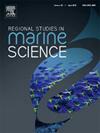印度东南沿海图蒂哥林地区有机氯农药、有机磷农药和重金属的生态毒理学意义及污染特征
IF 2.1
4区 环境科学与生态学
Q3 ECOLOGY
引用次数: 0
摘要
本研究工作调查了印度东南海岸图蒂哥林海岸的有机氯农药、有机磷农药、拟除虫菊酯和重金属浓度的来源、风险和季节变化。采用气相色谱/质谱法和原子吸收光谱法测定了农药和重金属残留浓度。水中的农药残留浓度为0.001至0.067 纳克/毫升,沉积物中的农药残留浓度为0.001至31.43 纳克/克,均在世卫组织和美国环境保护局规定的监管限值之内。分析表明,当地可能使用林丹作为六氯环己烷(HCH)残留物的来源,以及最近引入的二氯二苯基三氯乙烷(DDT)残留物。金属浓度的顺序Zn> Fe> 铜祝辞 倪祝辞 Mn祝辞 Cr祝辞 Pb祝辞 Cd祝辞 Se祝辞 Hg的水,和菲比; Mn祝辞 Zn> Cr祝辞 铜祝辞 Pb祝辞 倪祝辞 Cd祝辞 Hg祝辞 Se的沉积物。后季风季节沉积物中金属含量较高,随离岸距离增加而降低。河口Zn和Hg富集程度较高,而Cd在港口富集程度较高,污染程度从“未污染”到“中度污染”。在河口,泥沙性质对污染物的空间分布有显著影响,但在港口,由于人为来源的不同,相关性不太明显。这项研究的结果将有助于地方当局保护重要的水资源。本文章由计算机程序翻译,如有差异,请以英文原文为准。
The ecotoxicological implications and contamination profile of organochlorine pesticides (OCPs), organophosphorus pesticides (OPPs), and heavy metals, in Tuticorin, Southeast coast of India
This research work examined the sources, risks and seasonal variations in the concentrations of organochlorine pesticides (OCPs), organophosphorus pesticides (OPPs), pyrethroids, and heavy metals in the Tuticorin coast, Southeast Coast of India. The concentrations of pesticides and heavy metal residues were measured using GC/MS and AAS. Pesticide residue concentrations in water ranged from 0.001 to 0.067 ng/ml and in sediment from 0.001 to 31.43 ng/g, all falling under the regulatory limits set by WHO and USEPA. The analysis suggested the possibility of local lindane use as the origin for Hexachlorocyclohexane (HCH) residues and the recent introduction of dichloro-diphenyl-trichloroethane (DDT) residue. Metal concentrations were in the order Zn> Fe> Cu > Ni > Mn > Cr > Pb > Cd > Se > Hg for water, and Fe > Mn > Zn> Cr > Cu > Pb > Ni > Cd > Hg > Se for sediment. Metals had higher concentrations in sediments during the post-monsoon season and their concentration decreased with increasing offshore distance. The estuary exhibited severe enrichment of Zn and Hg, while Cd was highly concentrated in the port, reflecting pollution levels ranging from 'unpolluted' to 'moderately polluted'. In the estuary, sediment properties significantly impact the spatial distribution of pollutants, but the correlation is less pronounced in the port and harbor because of varying anthropogenic sources. The results of this study will aid local authorities in safeguarding significant water resources.
求助全文
通过发布文献求助,成功后即可免费获取论文全文。
去求助
来源期刊

Regional Studies in Marine Science
Agricultural and Biological Sciences-Ecology, Evolution, Behavior and Systematics
CiteScore
3.90
自引率
4.80%
发文量
336
审稿时长
69 days
期刊介绍:
REGIONAL STUDIES IN MARINE SCIENCE will publish scientifically sound papers on regional aspects of maritime and marine resources in estuaries, coastal zones, continental shelf, the seas and oceans.
 求助内容:
求助内容: 应助结果提醒方式:
应助结果提醒方式:


